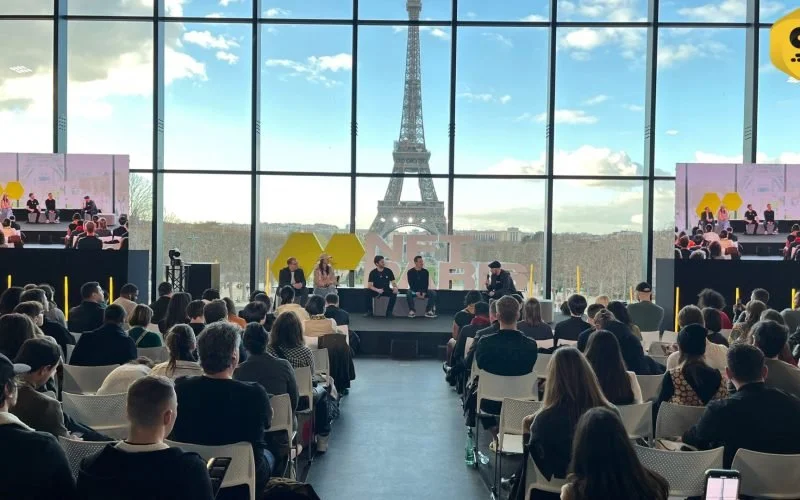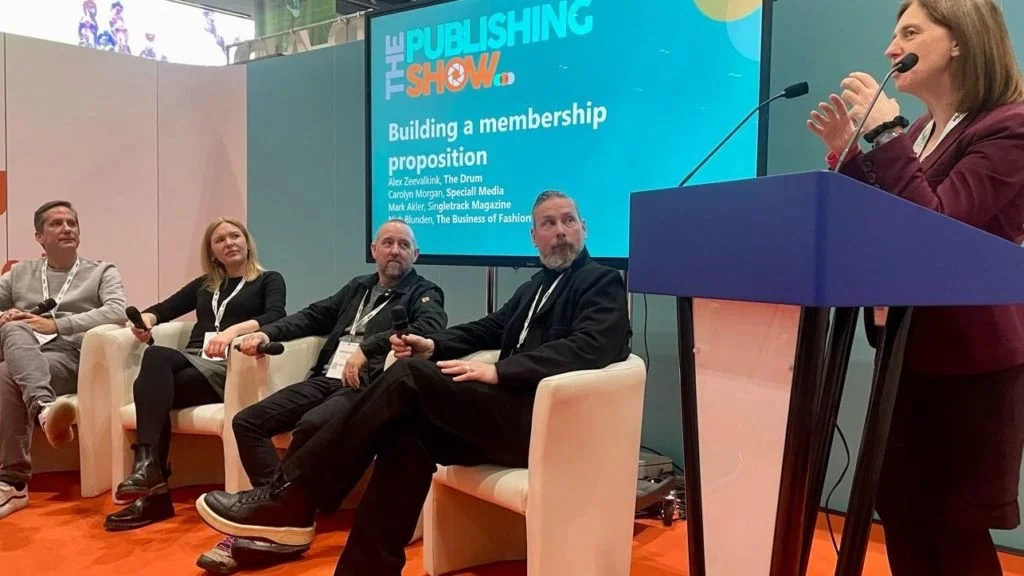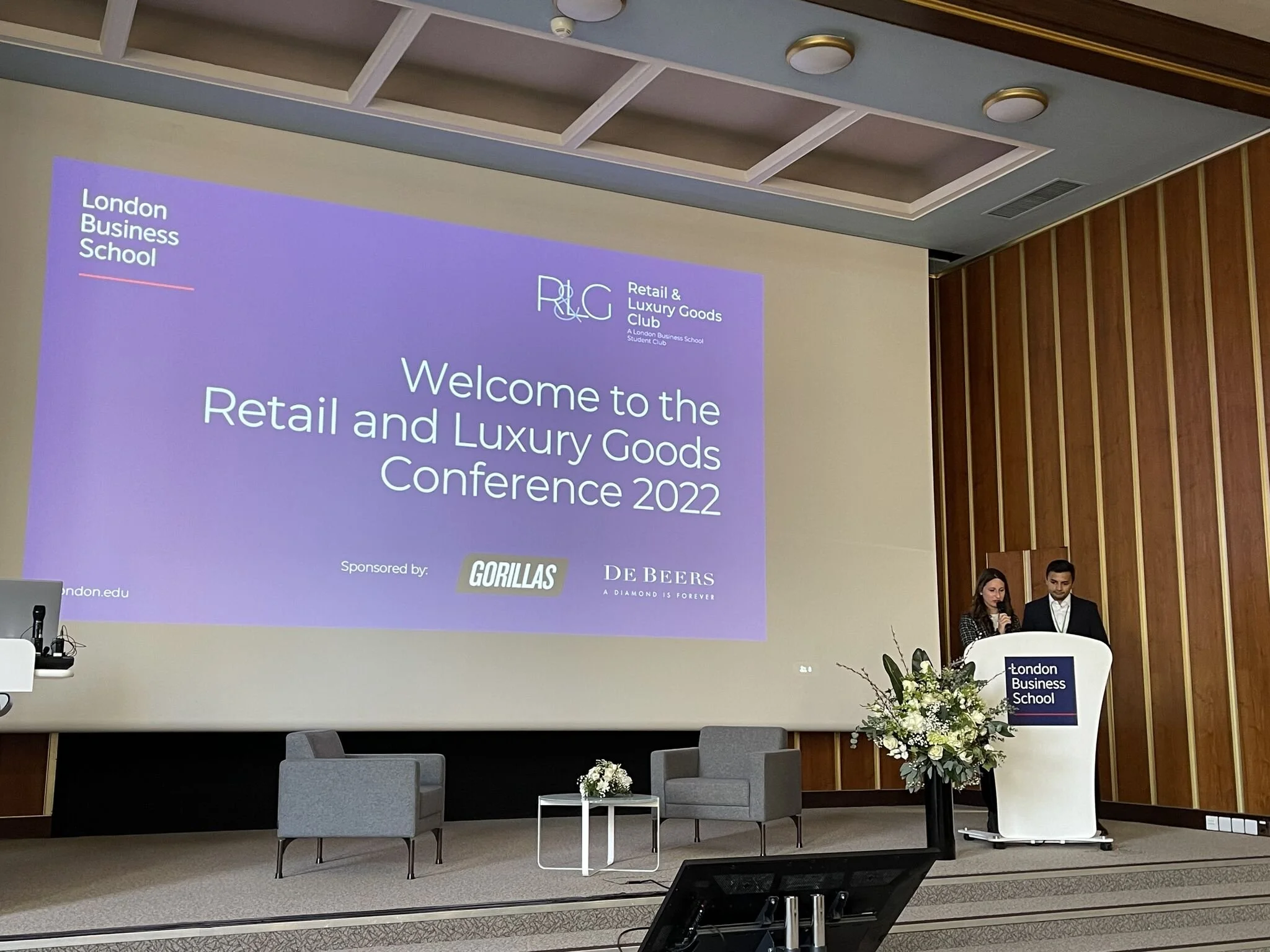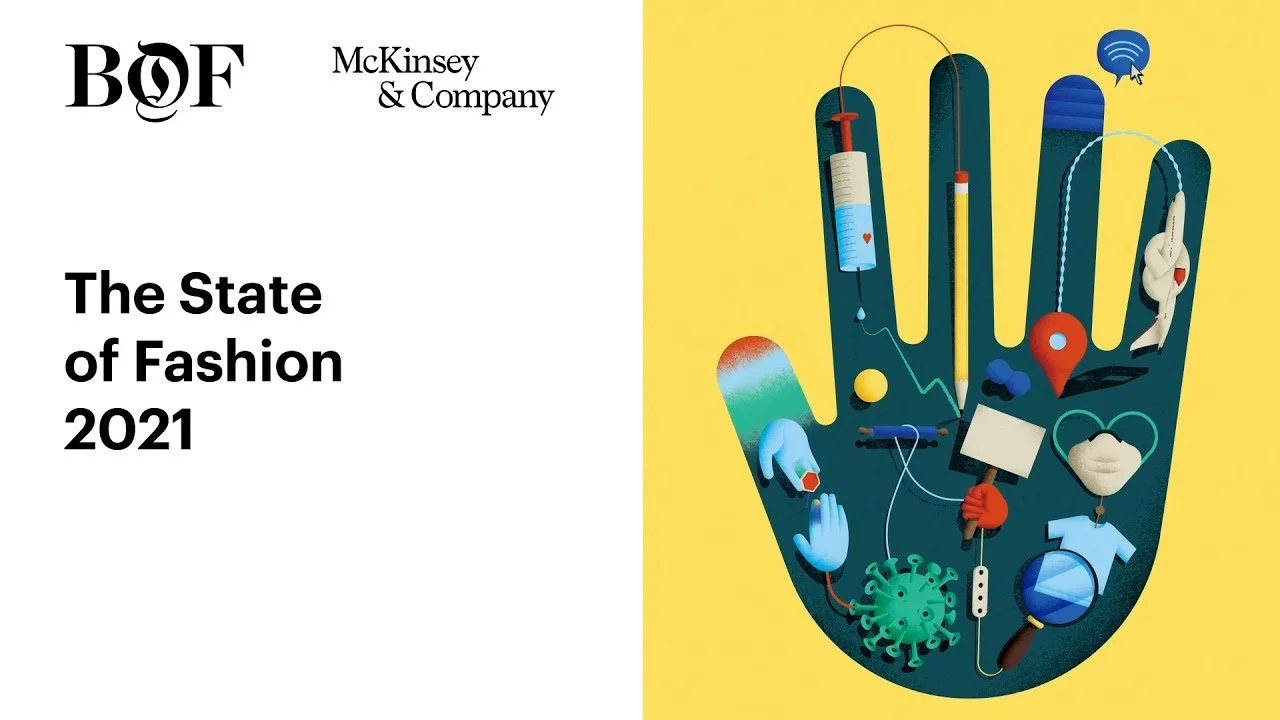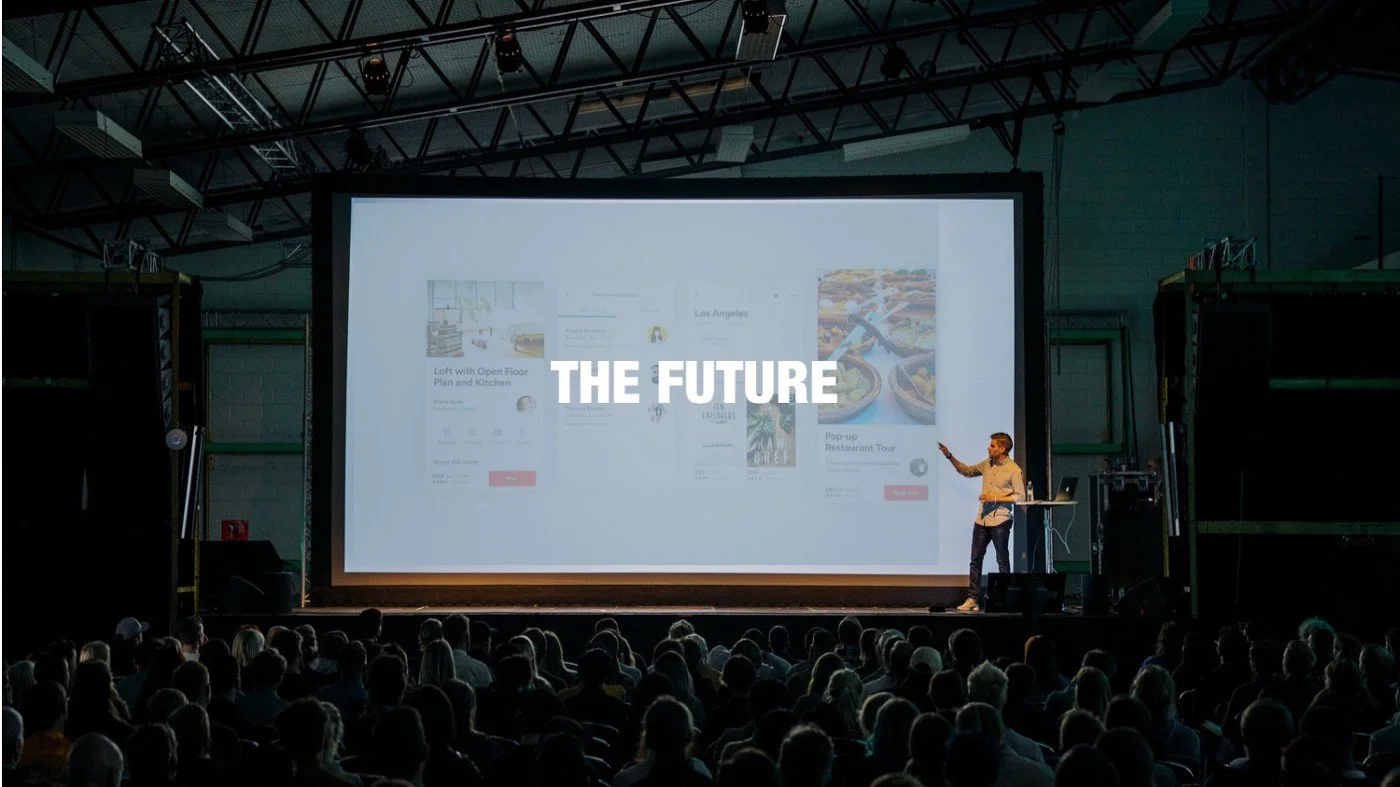NFT Paris 2024 - Web3 and Luxury: The Promise and the Paradox
It was such a pleasure to talk the brilliant Nelly Mensah, VP of Digital Innovation and Global Head of Web3 and Metaverse at LVMH, during NFT Paris 2024. As you can see from this video of our fireside chat she had plenty of really valuable insights to share.
NFT Paris 2023
It was such a pleasure to host a panel discussion at Europe’s largest NFT event NFT Paris on February 24th. The panel, which focused on how Web3 and NFT’s are creating a new fashion narrative, featured Jeremy Muras the Chief Digital Officer at Givenchy, Stephy Fung a leading digital fashion artist, Megan Kasper Managing Director of Firstlight and Florent Sroka the co-founder and CEO of SKINVADERS and took place at the amazing Grand Palais Ephémère in Paris.
The video of the panel can be found here.
Planet-Saving Innovations
I am delighted to be speaking at The Mills Fabrica’s flagship event, ‘Planet-Saving Innovations’ on Thursday 12th May.
As the official Innovation Partner for London Craft Week this year, The Mills Fabrica are convening a morning of enlightening talks and panels from the innovators behind trailblazing solutions for a better planet.
Featuring a special keynote from Anya Hindmarch, the British fashion designer creating luxurious products responsibly, inspiring talks from the innovators making waves within circularity; Renewcell and Reflaunt, an engaging conversation on ‘Clothes from the Future’ – Vollebak and Unspun, an insight into ‘The State of Fashion’ from The Business of Fashion, panel discussion on ‘Innovative Packaging’, solutions to fighting the plastic crisis – Xampla, Notpla and Shellworks and an educational talk on ‘Metaverse for Good’ from the Institute of Digital Fashion.
A video of the event can be found here.
Reflections on the Last Ten Years of the Luxury Industry
I had the pleasure of giving the keynote presentation at the 2022 LBS Retail and Luxury Goods conference and here is a transcript of my talk:
Reflections on the Last Ten Years of the Luxury Industry
Good Morning Everyone. My name is Nick Blunden and I am the President of The Business of Fashion.
I am really sorry that I can’t be there in person with you this morning, but some members of my family are in isolation today and therefore I thought it was better to be safe than sorry and do this presentation virtually. Nevertheless, I am delighted to be joining you remotely for what I am sure is going to be a great event.
So, I am going to kick things off by spending about twenty minutes sharing some reflections on the lessons we have learnt from covering the luxury industry here at BoF over the last ten years and perhaps most importantly looking at what those lessons might tell us about its future.
The State of Fashion Report
But before I jump into that I just wanted to give you a bit of context for this presentation. As some of you will know BoF in partnership with McKinsey and Company produces an annual report called The State of Fashion. This year’s report The State of Fashion 2022 is the sixth edition of the report and like its predecessors it is a forward-looking report that examines the themes, issues and opportunities influencing the Global Fashion Industry in the year ahead.
Much of the inspiration for this talk today comes from the research we have done to produce those six reports over the years but more than that I have also taken inspiration for today’s presentation from the format of the report. You see each State of Fashion report includes the ten trends that we believe will shape the year ahead in fashion.
You can see the ten trends for 2022 up on the screen now.
And, as this has proved over the years to be such a popular and effective way of analysing the fashion industry I have borrowed it for today’s presentation but rather than looking at the ten trends that will shape the fashion industry in the year ahead I am going to talk about the ten shifts that have shaped the global luxury industry over the last decade and what they tell us about its future.
And much like we do with the State of Fashion report I also have grouped these shifts together into categories.
Finance and Economic Shifts
So, let’s start by taking a look at the Financial and Economic shifts that have shaped the luxury industry over the last ten years.
From West to East
We begin with the shift in the global luxury industry from West to East.
Over the past decade or so, the luxury goods sector has expanded at a healthy rate of approximately two times global GDP growth, largely powered by the rise of China, where new waves of wealth creation have given birth to millions of new luxury consumers.
Indeed, Bain & Company estimates that mainland China’s share of the global luxury market reached 21% in 2021 which is a huge increase on ten years ago. And, furthermore that China is now well on track to become, the world’s largest luxury goods market by 2025.
In recent years, China’s early adopters have become more sophisticated. Some have likely already left the luxury goods market, which long ago became dependent on upwardly mobile “new money” consumers.
China’s second generation of luxury consumers are different: they want newness at a faster and faster rate. And as they have come to drive most of the luxury market’s growth, so too have they come to shape luxury’s new aesthetics.
Even more recently, deeper penetration of the Chinese social pyramid has provided major tailwinds for luxury mega-brands to the point where it no longer makes sense to talk about “the Chinese consumer.” There are now many clusters of Chinese consumers, defying broad-brushed generalisations.
So, while the rise of the Chinese luxury consumer has reshaped the global luxury industry over the last ten years, with China set to become the world’s largest luxury goods market in the next ten years their impact is only likely to increase.
From Competition to Winner Takes All
In addition to the shift from East to West and undoubtedly in part because of it we have also seen a dramatic shift in the competitive dynamic of the global luxury marketplace in the last ten years.
The escalating complexity of the luxury industry over the decade, driven in large part by the rise of China and the digital revolution (which I will talk more about later), has put an even greater premium on scale, playing to the advantage of companies with the human and financial resources required to manage on an increasing number of competitive fronts.
Larger brands have become the only ones with the deep-enough pockets to finance higher marketing costs, invest heavily in direct retail, develop first-class digital activities and to do so without traditional wholesale and grey market exposure.
As a result, performance has greatly diverged over the past ten years with the likes of LVMH, Hermès and Kering reaping the greatest rewards, while smaller luxury brands have found it much more difficult to keep up.
Indeed, over the last few years the global luxury market has increasingly come to look like a winner takes all one in which a select few “super winners” dominate.
This polarisation of the luxury industry is only likely to get more acute in the years ahead as the costs of operating in an increasingly complex global environment continue to increase. However, the good news is that it will not be an entirely closed shop.
Indeed, in our analysis of the global fashion industries “super winners” in this year’s State of Fashion report we noted that for the first time ever Moncler has joined Kering, LVMH, Hermes and Burberry as a luxury fashion super winner.
From Independent to Consolidated
For some of the same reasons that have driven the winner takes all dynamic, the last ten years have also seen waves of significant consolidation in the luxury sector.
Indeed, in some ways the past decade could be seen as a tale of how one French luxury conglomerate streaked ahead of the competition.
By the time LVMH paid just over $5 billion for Italian luxury jewellery company Bulgari in 2011, it had already built an impressive portfolio of brands, including Louis Vuitton, Givenchy and Sephora.
Over the course of the ten years since, LVMH has added a few more to this portfolio including: acquiring German luggage company Rimowa; entering into a joint venture with Stella McCartney; launching Fenty with Rihanna; not to mention the $13 billion integration of Christian Dior in 2017. And, of course most recently the $16 billion acquisition of American Jeweller Tiffany & Co that finally closed early last year.
Off the back of this decade long acquisition spree LVMH became in 2021 Europe’s most valuable company and for a time Bernard Arnault its CEO was also the world’s richest person.
But LVMH has not been the only driver of consolidation in the luxury industry over the last ten years. There have been plenty of other notable deals as previously independent businesses have been snapped up to form larger luxury holding companies.
In 2017 Coach acquired Kate Spade in a deal worth $2.4 billion as part of a wider plan to create an American luxury conglomerate under the new name Tapestry Inc.
Then in 2018 Michael Kors Holdings bought Versace to form Capri Holdings also in an attempt to build an alternative American luxury conglomerate.
And, most recently in 2020 Moncler acquired Italian brand Stone Island in what could be its first step towards becoming another European luxury conglomerate to rival Kering and LVMH.
Looking ahead to the next decade this consolidation of the luxury industry is likely to continue with LVMH’s purchase of Tiffany triggering a fresh wave of luxury mega-deals as long as there remain companies left to buy.
Digital and Technology Shifts
Now lets move to look at the digital and technology shifts that have shaped the luxury industry over the last ten years…
From Physical to Digital
Ten years ago luxury was very much a physical industry. Indeed, despite the extraordinary success of online retailers like Amazon, in 2011 some luxury executives were still questioning in public whether consumers would ever really want to buy luxury goods such as handbags online in any great number.
Fast forward to 2022 and there really is no question that the luxury industry has gone digital. While it may still lag behind other industries in terms of digital innovation, the digital genie is nevertheless well and truly out of the bottle.
Fuelled by the Covid-19 pandemic the share of luxury purchases made online in 2020 reached 23%, up from 12% in 2019. While this rate of growth will undoubtedly slow as the coronavirus moves from pandemic to endemic there is now a very clear path to online luxury sales overtaking offline luxury sales globally in the decade ahead.
But beyond just the way luxury products are sold digital has more fundamentally rebooted the way luxury works over the last ten years. Opening it up to a far wider customer base, changing the way luxury products are made and dramatically reshaping the way luxury brands are built.
Looking ahead the big digital question for the luxury industry seems to be the extent to which the Metaverse, as the next big digital frontier, will impact the industry in the same or even greater ways.
While, there is some justifiable caution at the hype surrounding the Metaverse and all things Web 3.0, the speed with which luxury brands like Balenciagia and Gucci are embracing it suggests that the lessons have been learnt from the relatively slow adoption of digital in the last ten years and that it will become an absolutely fundamental part of the luxury eco-system.
From monologue to conversation
In the last ten years, digital technology has also rewired the way luxury brands communicate with consumers: from monologue to conversation, from low-frequency to high-frequency, from mass market communications to segments of one, all supported by exploding amounts of data.
This new media reality has broadened the audience for luxury brands and put pressure on companies to develop new expertise and processes, as well as a steady stream of fresh products for a world in which the rise of social media platforms like Instagram and TikTok have contributed to the demand for newness.
It has also had a significant impact on the relationship between luxury brands and the media that used to rely on.
On the luxury fashion side magazines may have once been the consumer’s only way in, but today, fashion shows are broadcast live and designers happily post “candid” photos of their living rooms.
In the past decade, as every luxury fashion brand became a media brand, many venerable publications have lost their reason for existing — or have ceased to exist altogether.
Given that the relationship between media and luxury brands is now less symbiotic than it once was, it's not surprising that some of the most successful luxury fashion brands of the last decade — including Céline, Saint Laurent and The Row — have been led by designers that rarely interact with the press.
In the last few years there have been plenty examples of how well-established luxury brands have leveraged this new media reality to turbo charge their growth and unlock new markets, Gucci being perhaps the best and most obvious example.
However, in the years ahead this digital reconfiguration of the marketing and media landscape and the new opportunities it creates opens the door for at least some new luxury brands to reach global scale without the advantages that their more well-established competitors enjoy.
Social and Cultural Shifts
I’d now like to move on to look at the social and cultural shifts that have most impacted the luxury industry over the last ten years…
From Conspicuous Consumption to Sustainability
For years, luxury titans Kering and LVMH have competed aggressively for deals, designers and retail space. But in the last couple of years the biggest contest between the French luxury giants has come down to climate.
It’s hard to imagine these global luxury conglomerates slugging it out over sustainability 10 years ago, though both companies did already have initiatives in place. Back then, few customers, and even fewer luxury executives, cared enough about these issues to influence major commercial decisions. But over the last decade, the conversation about climate issues within the luxury industry has radically shifted.
Now, the imperative is on luxury brands to show their businesses are not just financially sustainable, but also morally supportable. Since 2010, a host of technological, social and political upheavals and public scandals have drawn attention to the industry’s social and environmental misdeeds. On the flipside, a new generation of value-driven consumers are creating positive incentives for luxury brands to show they are operating more responsibly.
As the luxury industry emerges from the worst of the coronavirus pandemic frank talk about its environmental impact is table stakes. Luxury brands large and small face pressures that may finally force fundamental changes to how the industry operates.
Luxury consumers are becoming more knowledgeable, more demanding and more active. Governments and regulators are also now paying more attention to the industry. While investors are also increasingly motivated to hold luxury companies to account for their environmental impact.
The results of these cultural and political shifts on the industry have been amplified by the rise of social media and a generation of activist consumers. Where ten, or even five, years ago taking any kind of political stance was anathema to most luxury businesses, it is now becoming increasingly common.
As a result, over the next ten years sustainability will move from being a source of competitive differentiation in the luxury industry as it is now to become a fundamental prerequisite for entry into the luxury market.
This will require the luxury sector to find a way to reconcile its focus on sustainability with increasing demand for its products and the need to drive growth.
From Haute Couture to Streetwear
It’s no secret that streetwear has become a critical part of luxury’s business model, helping to drive blockbuster results in recent years for major brands like Gucci, Dior and Balenciaga.
At the heart of the shift is a new generation of consumers, who grew up with hip-hop, skateboarding and basketball, and have long mixed their Supreme with their Dries Van Noten.
Generations Y and Z are already the main growth engine of the luxury market. By 2025, they are expected to account for 45 percent of total luxury spending. But this underestimates their influence. A “Millennial mindset” has rapidly taken hold in the luxury market in recent times, transforming consumer preferences across all generations.
On the back of this shift, streetwear has become a key driver of luxury sales growth. In particular, the category has helped to restore luxury’s appeal with men amid declining demand for suiting, watches and formal shoes.
Streetwear has also brought the luxury industry compelling new sales and marketing strategies, from product “drops” that generate buzz and are more in sync with consumer expectations for newness at the speed of social media to new community-building efforts that tap into eagerness, not just for cool-looking clothes, but something to believe in and belong to. Brands have discovered that when the engaged communities built by streetwear designers collide with the clout of a luxury logo, they can sell hoodies for the price of a suit.
Looking forward the importance of streetwear to the luxury industry is unlikely to diminish anytime soon. Indeed, over the next ten years streetwear may well become as significant an addition to luxury’s business model as a category like beauty, which also came with millions of new consumers, new marketing and distribution strategies, and highly favourable economics.
Consumer and Product Shifts
Finally, I’d like to now take a look at the consumer and product shifts that have shaped the luxury industry over the last ten years…
From Accessible Luxury to True Luxury
And to start I’d like to focus on the way the concept of Accessible luxury has evolved.
Coach, Michael Kors and other brands that form the backbone of American luxury fashion have, over the last year and a half, entered something of a renaissance. Using the industry-wide disruption caused by the pandemic as cover, they cut back on inventory, offered fewer discounts, closed stores and pulled out of some department stores and other faltering retailers.
It was a painful but long overdue correction. Over the last three decades, these brands have ballooned into multi-billion-dollar businesses with global footprints predicated upon their ability to sell a taste of the good life for a fraction of the price of a European luxury brand.
But while the 2008 financial crisis fuelled the growth of “accessible” luxury, it also squeezed the middle class that made up the category’s core customers. Those who still had some money to spend quickly discovered they had plenty of options, whether it was a $600 Gucci t-shirt, or a fast fashion knockoff. Brands like Kors and Coach responded by slashing prices and pumping out more and more styles, flooding shopping malls, department stores, outlets and e-commerce sites with product. Once they joined the race to the bottom, these brands couldn’t stop; shoppers came to expect bargain prices for designer names.
But more recently these accessible luxury brands have now found their footing by sharpening their point of view to create products their customers want at full price, selling more of their products directly to customers and modernising their marketing.
This is a similar approach to the one taken by Burberry another accessible luxury brand that is reinventing itself as a true luxury player.
Indeed, while the accessible luxury segment will continue to exist over the next ten years it is likely to shrink in size and importance as its most successful exponents gradually move up from accessible luxury to true luxury.
From Wholesale to Direct Sale
Even before the Coronavirus pandemic forced luxury brands to question every element of their distribution strategy in the face of lock downs, store closures and collapsing demand we had been seeing a slow but nevertheless significant move away from the wholesale model among the largest global luxury brands over the last decade.
Indeed, as an example in 2019 just before the pandemic began the Prada Group announced that it would streamline its wholesale distribution both online and in stores, citing the "growing complexity and fragmentation of the wholesale market."
At the time 82 percent of Prada's sales already came from its direct retail activities, which included more than 630 owned stores as well as its e-commerce enabled website. But publicly declaring that it would contract further was a still a notable statement of intent.
Similarly, over the last few years most if not all of the major luxury brands from Kering owned ones like Gucci and Bottega Veneta to LVMH owned ones like Louis Vuitton and Christian Dior have invested heavily in opening and refurbishing their own stores at the expense of their wholesale accounts.
The reasons for this significant change in distribution strategy over the last few years are consistent across all these luxury brands.
Direct retail gives luxury brands: greater control over their brand and identity, closer relationships with the end customer and more control over their commercial strategy.
As a result of these changes the last decade has been tough for luxury multi-brand retailers as a whole and high-end department stores in particular.
Historically, department stores and other multi-brand retailers were successful because they made it more convenient to buy things. But in the last ten years e-commerce has made it easier than ever to purchase anything, anywhere dramatically reducing their competitive advantage.
This has led many to question whether we will see the death of both wholesale and the department store model in the years ahead. However, while there is no doubt that the luxury wholesale channel will be smaller in the next ten years then it was in the last ten it will certainly not die entirely.
After all, for emerging luxury labels looking to gain name recognition, partnering with multi-brand retailers, most of which operate within the wholesale model, remains important.
Furthermore, while the department store model will continue to come under pressure in the years ahead, those like Selfridges in London and Le Bon Marche in Paris that are able to offer a unique multi-brand luxury shopping experience will still flourish.
Indeed, the recent sale of Selfridges’ for more than $5 billion dollars suggests there is still life in the wholesale and department store model yet.
From Ownership to Resale
Over the last decade, the luxury resale space, once dominated by eBay, has birthed a wave of “eBay meets Net-a-Porter” platforms like Vestiaire Collective and The RealReal, which offer curation, authentication and excellent service.
Now, major luxury brands — long wary of the secondary market for fear of brand dilution — are paying serious attention to a business model that’s gaining significant traction with Gen-Z and Millennial consumers, who are set to account for more than 60 percent of total luxury spending by 2026 and for whom access trumps ownership and sustainability is a growing concern.
There is clearly significant consumer interest in second-hand luxury goods and research shows that rather than cannibalising full-price sales, second-hand products sold at a discount widen the market for luxury goods and provide more affordable entry points to high-end brands, thereby serving as a gateway for first-time buyers.
There is also mounting evidence that secondary market sales support sales of new goods as consumers come to see the ultimate cost of a product as its sticker price minus its eventual resale value, boosting perceived affordability.
As a result, in the last few years luxury brands have come to the realisation that the second-hand market is not actually detrimental to the primary market. This helps to explain the flurry of recent deals, such as Kering’s investment in Vestaire Collective, that have seen luxury players get much more directly involved in the resale space.
In fact, partnering with resellers allows luxury brands to tap into a whole new customer base — typically younger, and looking to buy at an entry-level price point — in the same way small-ticket items like cosmetics and sunglasses have done for years.
Meanwhile, post-pandemic consumer trends towards value and sustainability are likely to fuel further growth in the resale space in the future.
In the short-term this means we are likely to see even more partnerships between luxury brands and established resale players. However, longer term we may see more luxury brands bringing resale in-house, much as luxury automobile makers have launched certified pre-owned programs, bringing greater trust and order to the secondary market while taking a more significant slice of second-hand sales.
The Next Ten Years of Luxury Fashion
So, as I have gone through each of the ten shifts that have most affected the luxury industry over the last decade in this presentation I have tried to highlight what impact I think they will have on its future.
However, to draw things to a close I would like to conclude with one final thought about the future of the luxury industry…
Balancing Product, Profit and Planet
The V-shaped recovery of the global luxury industry after the sharp pandemic induced contraction of 2020 has been nothing short of remarkable. And, of course this resilience bodes well for the outlook for the industry over the next ten years.
However, a once in a lifetime event like a global pandemic also presents the need for something of a reset. And, in this context the future of the luxury goods industry is likely to require a better balance between creating products that are more inclusive than exclusive, all while more effectively managing the inherent tension between the needs of the planet and the needs of its shareholders.
Thank You
So that’s all I’ve got time for this morning but thank you all for joining me today.
Tapping Into the Future of Physical Retail
I gave a presentation on the future of physical retail as part of Informa Markets Fashion live digital digital discovery sessions.
The presentation was based on a brilliant BoF case study written by the brilliant Cathaleen Chen which is available to download here.
A write-up of the presentation can be found here.
And a video of the presentation can be found here.
Customer-Centricity Through a Retail Lens
I spoke at the London Business School Retail and Luxury Goods Club conference in 2019. A summary of the event can be found here.
Two Oceans Marathon
In 2014 I ran the Two Oceans Ultra Marathon in 06:49:53 alongside Chi Lo, Chris Janzen and Graeme Urwin.
Here is a documentary about the race.
Napa Marathon
It all begins with an idea.
In 2012 I ran the Napa Valley marathon in 4:08:21.
New York City Marathon
It all begins with an idea.
In 2001 I ran the New York City Marathon in 3:43:34.



